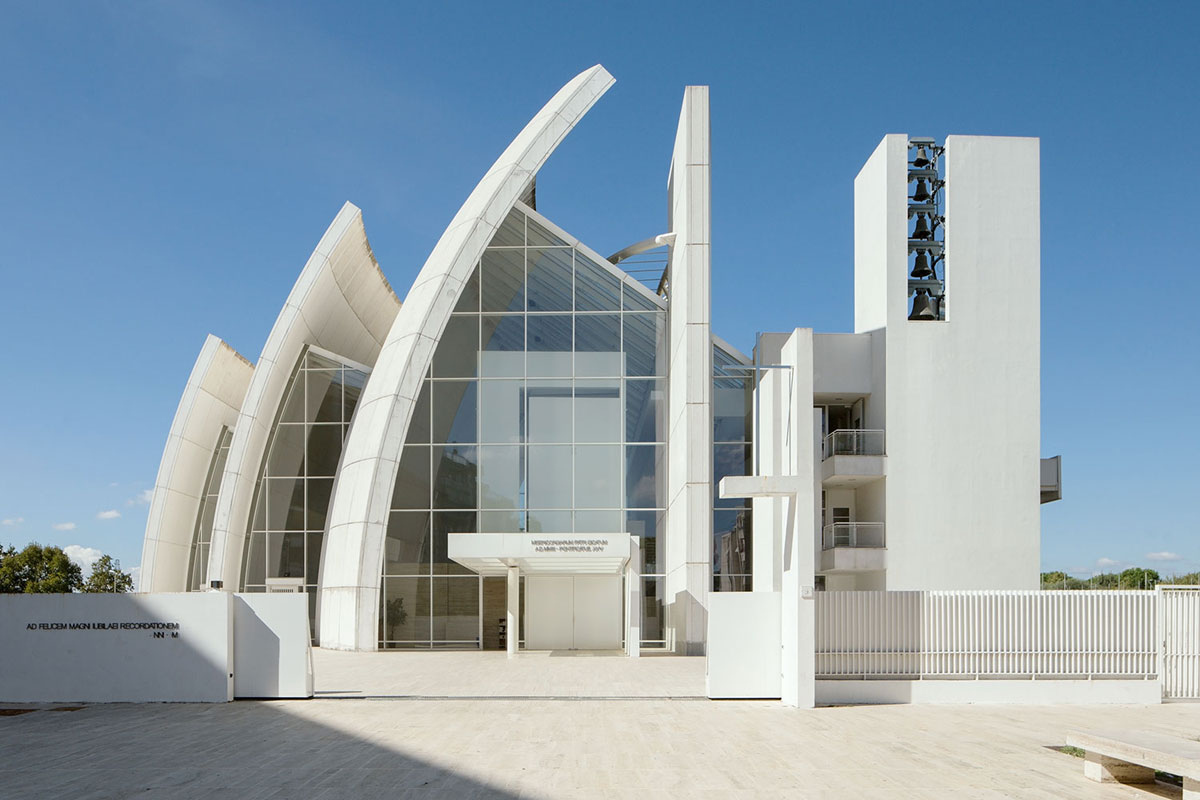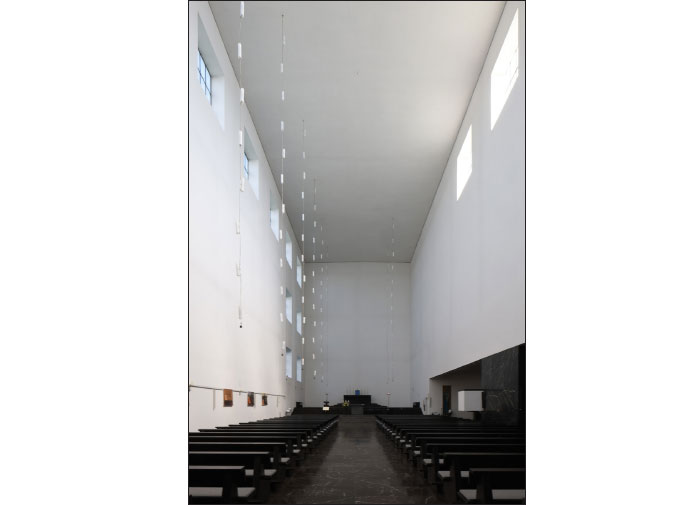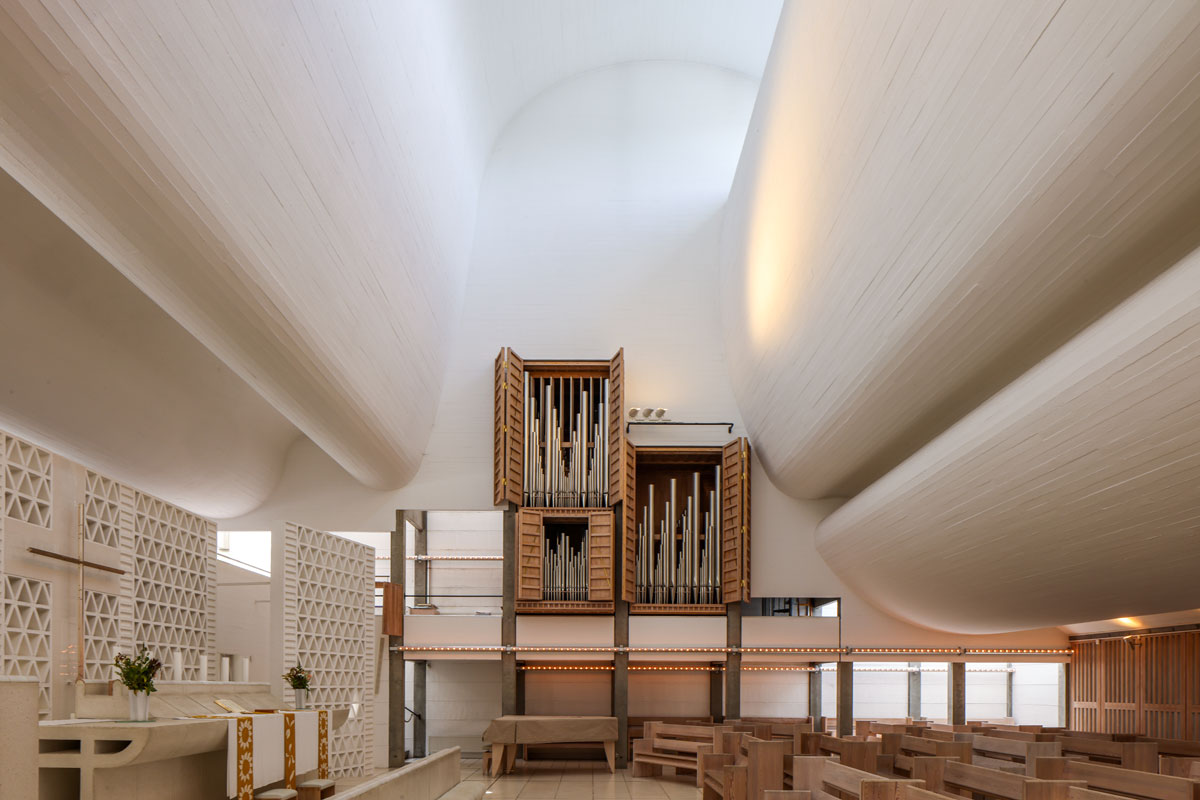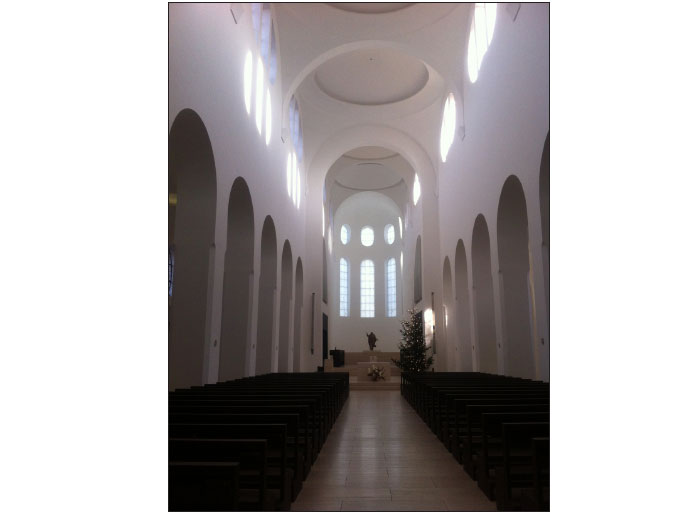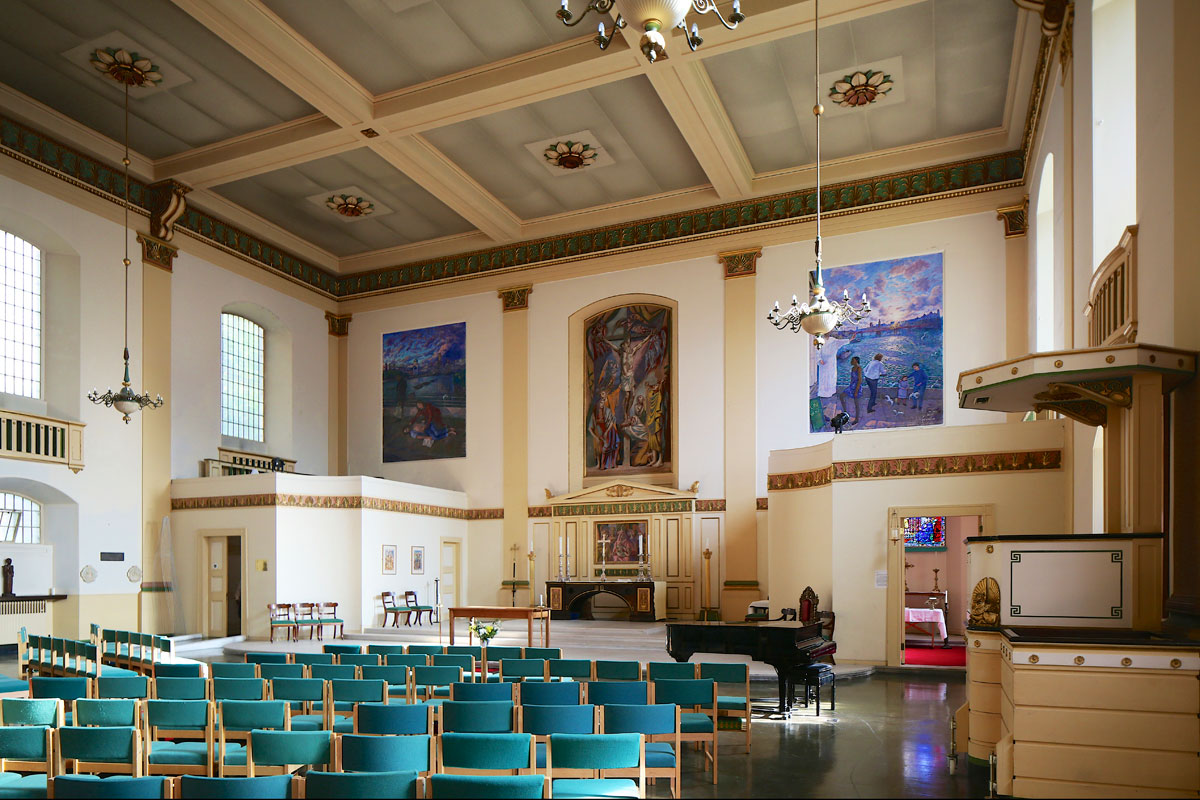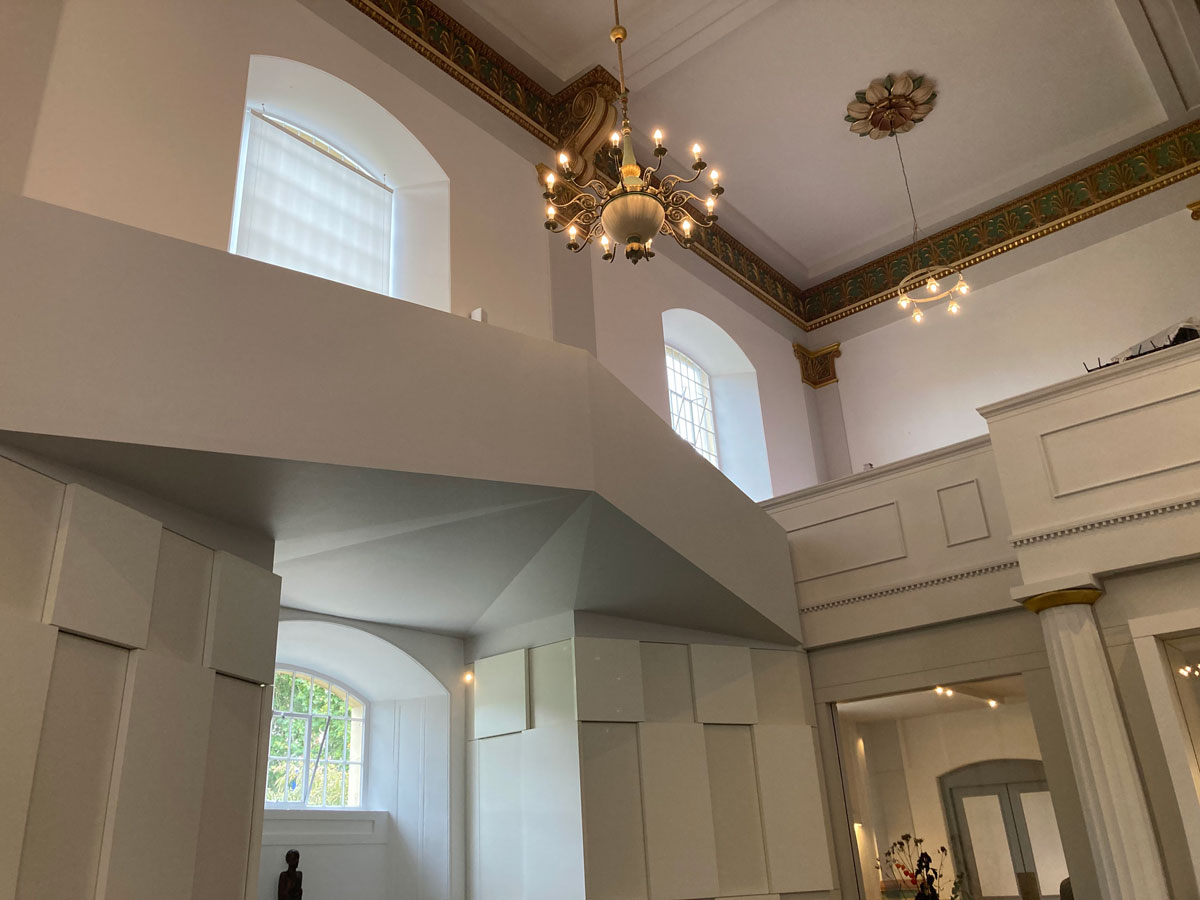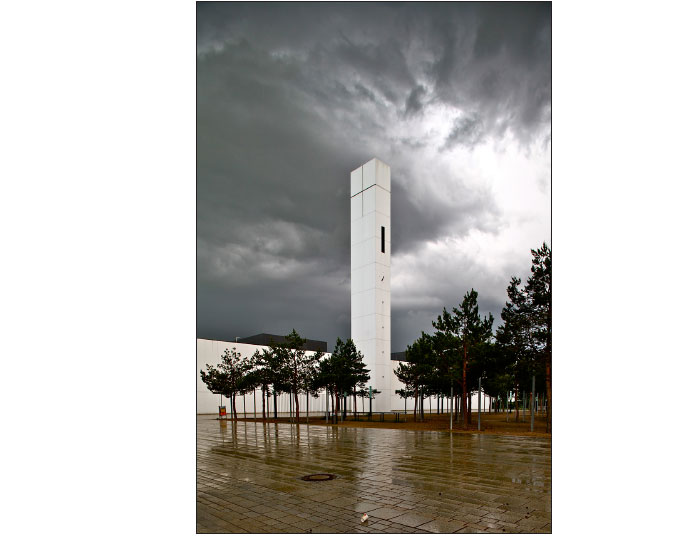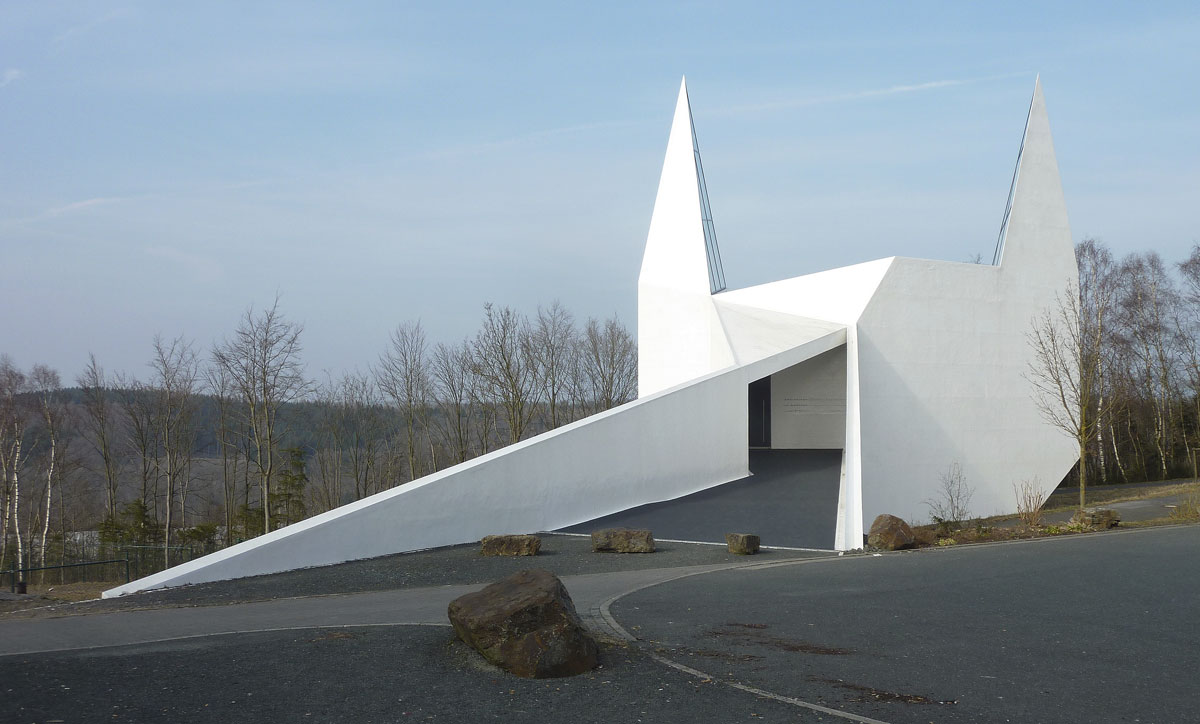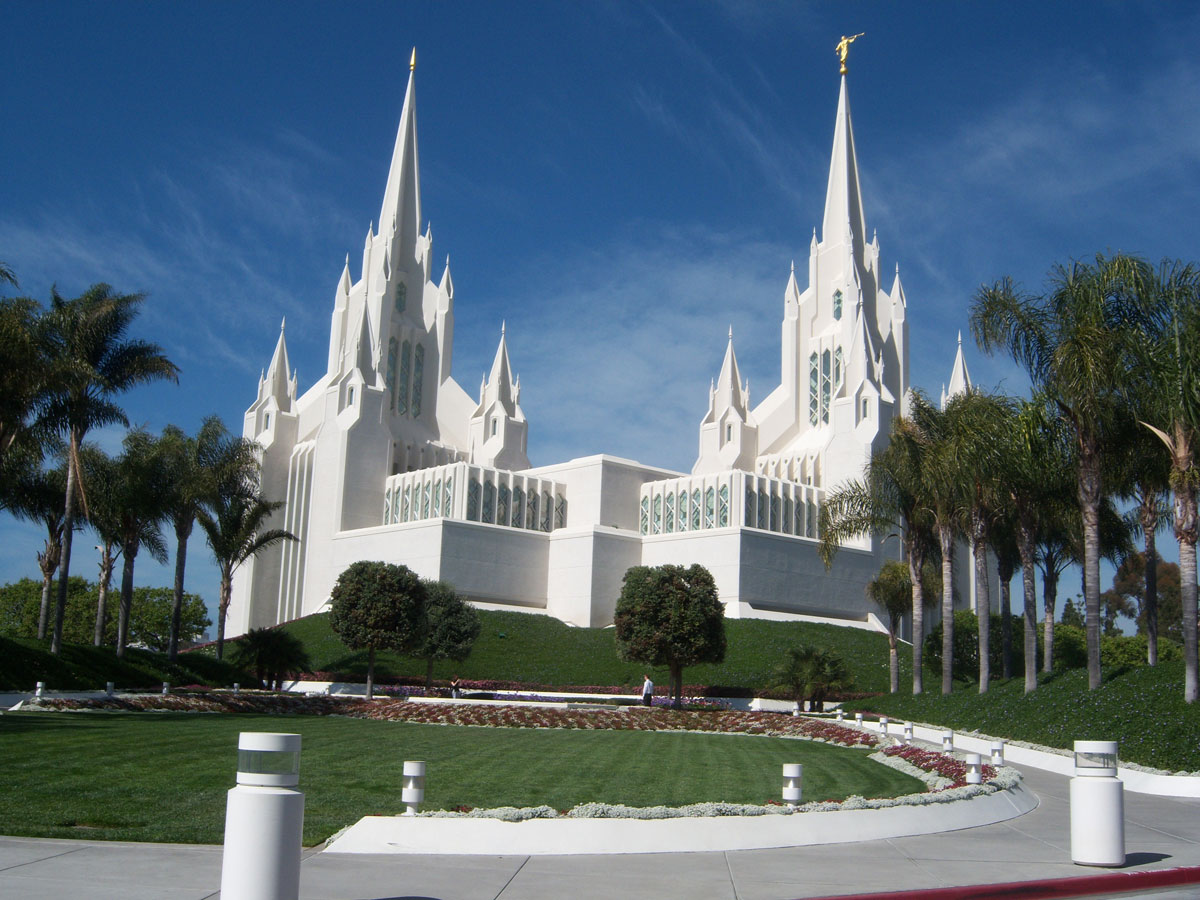Following an international competition in 1996, the Vicariate of Rome commissioned the American architectural firm of Richard Meier and Partners to design a landmark church to mark the millennium.1 The Church of the Year 2000 (Chiesa di Dio Padre Misericordoso), commonly called the Jubilee Church in English, was to be an iconic building that expressed the relationship between the Roman Catholic liturgy and architecture in the 21st century (Figure 1). Specifications for the project were laid out in a document produced by the Vicariate: the selected architect would be given free rein in the design of the church, with the only stipulation being that the architect would be ‘gently asked to represent in his work the timelessness of beauty’ (Dillinger and Ford 1998: 10). The building that Richard Meier produced is modest in scale, radical in form,2 and, as the client presumably anticipated, given Meier’s oeuvre, entirely white.3 On this matter, Meier was emphatic:
White is the most wondrous color because in it you can see all the colours of the rainbow. The whiteness of white is never just white. It is almost always transformed by light and that which is changing: the sky, the clouds, the sun and the moon. (Richard Meier, quoted in Daelmens 2015: 85; italics mine)
Jubilee Church (Chiesa di Dio Padre Misericordoso), Rome, Richard Meier and Partners, 2000. Photo by Vincenzo Pentangelo, 2015. CC BY-SA 4.0, https://commons.wikimedia.org/w/index.php?curid=43819026.
Though far from the only entirely white church designed in the second half of the 20th century, the Jubilee Church helped embed both material and symbolic whiteness as an enduringly powerful theme in contemporary church architecture across the globe and within all denominations (for a discussion of whiteness in relation to the Jubilee Church, see George 2012: 44).
The prevalence of whiteness as a metaphorical or aesthetic device in 21st-century church architecture deserves more attention.4 What, for example, does the use of whiteness offer as an organizing principle for reading contemporary church architecture? Beyond religion, do white churches also tell us something about secular landscapes?5 To what extent does material whiteness overlap with whiteness as a historically constructed category of race? It is beyond the scope of this short essay to explore all of these important lines of enquiry – much less to provide answers. In the following I will instead focus on the relationship between whiteness, architecture and contemporary worship practices and attempt to formulate some productive questions that will inform a future study of whiteness in contemporary churches.6
The use of white as a trope in church architecture has a long history, and its relationship with theology is complex and contested.7 In her 2012 volume Whitewash and the New Aesthetics of the Protestant Reformation, Victoria George reveals the currency of whiteness in early-modern Protestantism. George argues that whiteness was central to the culture of ascetic Protestant denominations, particularly Calvinism and Lutheranism, which were shaped in opposition to the opulence of Counter-Reformation Catholicism. The consequent whitewashing of medieval church interiors was widespread across Protestant Europe and ended, according to George, in a second wave of puritan iconoclasm (between 1643 to 1644) during the English interregnum. Such practices, George suggests, were more than merely a rejection of Catholic visual culture or an act of desecration: ‘the whitewashed interior formed a central element of a new iconography of faith, reflecting a particular intellectual orientation to color, primarily acquired through the Bible’ (George 2012: 6). In George’s account, the colour white itself bore a spiritual and metaphorical significance in Protestant theology.
Successive revivals of symbolic whiteness in European churches illustrate its enduring significance in Christian visual cultures. For example, in the Liturgical Movement, which transformed Catholic worship over the 20th century, both theology and architecture were reconfigured to foreground the liturgy over informal devotional practices, which focused on the veneration of saints and relied on visual aids such as statues and paintings. The relationship between liturgical reform and architecture was theorized in the 1920s and 1930s by, among others the Roman Catholic priest Romano Guardini and the architect Rudolf Schwarz. For Guardini and Schwarz, the emphasis placed by the Liturgical Movement on the primacy of the word suggested economy and simplicity. This theory takes form in Schwarz’s design for the Church of Corpus Christi in Aachen (1930) (Figure 2), which features a radical stripped-back interior with white walls that boldly contrast with the black floors and pews (see Schwartz 1958). In early 20th-century Britain, the English Use Movement, led by the Anglican priests Percy Dearmer and Vernon Staley and seen in the work of Ninian Comper, Temple Moore and others, was a reaction to high Victorian Gothic and saw a return to the use of white interiors as well as clear glass windows. Dearmer’s The Parson’s Handbook, first published in 1899, set out to reverse what he saw as the growing commercialisation of liturgical design and decoration by reconnecting architecture with the Book of Common Prayer (1907: 6). The movement laid the way for churches such as Guildford Cathedral, designed by Edward Maufe, begun in the 1930s and finished in 1965, with its vast and simple, white interior. Guardini and Schwarz’s ideas were taken further elsewhere in postwar Europe, notably by the Dutch monk-architect Hans van der Laan, who built on the theme of whiteness and light (Van der Laan 1983). As a result, the fashion for decoration and colour in churches began to wane in Europe and beyond from the middle of the 20th century onwards.
Throughout the second half of the 20th century, whiteness was often employed as an aesthetic device in churches that employed functionalist design principles. Though the enduring taste for minimalism continued to be driven by the Liturgical Movement (across all denominations), it was also an opportunity to experiment with new building techniques and styles.8 An emphasis on the relationship between space, form and light produced numerous postwar churches that feature whiteness in the exterior or interior design scheme. Sometimes this was contrasted with colour or darkness, as at Le Corbusier’s Notre-Dame du Haut, Ronchamp, and the Couvent Saint Marie de la Tourette, Lyons. At other times, whiteness was interrupted only by minimal timber fittings and pews such as at Jorn Utzon’s Bagsvaerd Church, completed in 1976 (Figure 3) and Alvar Aalto’s Santa Maria Assunta (1978). The collaborations between Le Corbusier and the French priest and Dominican friar Marie-Alain Coutuerier produced designs that were highly theorised.9 The designs for Santa Maria Assunta and the Bagsvaerd Church, however, were underpinned by cultural references rather than theology and might be considered examples of critical regionalism. Indeed, in his analysis of the Bagsvaerd Church, Kenneth Frampton suggests that Utzon deliberately ‘rejects semantic religious references’ in response to the secular age (Frampton 1983: 23).10 In all cases, whiteness was employed for its powerful visual effect.
The examples above illustrate the ways that whiteness, whether as a colour or simply an absence of colour, have been employed in church architecture. While it is not the only discernible trend from the 1990s onwards (timber and natural materials are also popular11), whiteness as a device or motif is the signature of many influential modern churches, among which John Pawson’s Abbey of Our Lady of Nový Dvůr, Czech Republic (commissioned in 1999), and Alvaro Siza Vieira’s Santa Maria at Marco de Canavezes (1996) continue to inspire architects (e.g., Lynch 2016: 41–55). The architectural press offers consistent evidence for the abiding taste for white churches. For example, of the predominantly white churches featured in the British magazine Dezeen’s top ten best churches in 2019, the Church of the Penitent Thief in Bologna stands out for being little more than a windowless white box (Ravenscroft 2019). Of the top eight churches featured in the magazine in 2020, three make a thematic use of whiteness: the porcelain-clad Østre Porsgrunn church in Norway by Espen Surnevik, the Castel di Lama church in Italy by Contini Architettura, and the whitewashed concrete interior of the Church of Saint John Paul II in Páty, Hungary by Robert Gutowski Architects (Ravenscroft 2020). And in 2022, the Chamber Church, an entirely white building in Qingdao, China by Büro Ziyu Zhuang was long-listed for a Dezeen Award (Dezeen Awards 2022).12
Whiteness is not limited to purpose-built churches. In his celebrated refurbishment of the Moritzkirche in Augsburg completed in 2013, for example, Pawson developed his thematic use of white in an interior scheme that inspired the effusive monograph, Built Towards the Light: John Pawson’s Redesign of the Moritzkirche in Augsburg (Figure 4).13 Nor is the contemporary use of whiteness as a motif confined to high-profile churches. Examples of this can be seen in modest refurbishments of parish churches across the UK where once colourful interiors have been transformed in recent years by whitewash. Such schemes include St John at Hackney, London, and St John’s Waterloo, also in London. Figure 5 shows the distinctive ‘Festival of Britain’ colour scheme at St John’s, Waterloo, which was repainted white (with some of the Greek Revival details picked out in colour) in the 2022 refurbishment by Eric Parry Architects (Figures 5 and 6).14
St John’s Waterloo: Interior refurbishment by Eric Parry Architects, completed in 2022, Photograph by Kate Jordan, 2022.
The conspicuous use of white in contemporary church architecture is not tied to particular theologies, as it was during the Protestant Reformation or the Liturgical Movement.15 Today, white appears to be applied thematically across all denominations. Austere white Catholic churches such as the Kirchenzentrum in Riem completed in 2004 (Figure 7), for example, are as numerous as white Evangelical Lutheran churches, such as the Ålgård Church in Rogaland, Norway (2015).
The visual neutrality of non-denominational churches such as the White Church in Guangzhou, China (2015) and the Autobahnkirche Siegerland in Wilnsdorf, Germany (2013) (Figure 8), the latter positioned by the side of the road to serve spiritually hungry motorists, perhaps meet our expectation of what an ecumenical building should look like: these privately funded initiatives have much in common with the multi-faith spaces that are found in airports and shopping malls. Perhaps more surprising, considering the liturgical and ritual significance of decoration in the Russian Orthodox Church, is the white, minimalist Church of Hieromartyr Ignatius of Antioch, currently under construction in Moscow.16 Elsewhere, the pristine white churches of the Church of the Latter-day Saints seem to have a unique symbolic and theological significance (Figure 9).17 What is significant in all the examples, however, is the increasingly generic character of many modern white churches.
Autobahnkirche Siegerland, Wilnsdorf, Schneider and Schumacher, 2013. Photo by Frank Behnsen, 2015, CC BY-SA 3.0, https://commons.wikimedia.org/w/index.php?curid=39660353.
San Diego California Temple, William S. Lewis Jr., 1984. Photo by XeresNelro, 2008, CC BY-SA 4.0, https://commons.wikimedia.org/w/index.php?curid=65353246.
If whiteness is no longer determined by theology, then one way of accounting for its prevalence in contemporary church architecture is that it is simply fashionable. But as the church historian Peter Anson tells us, ecclesiastical fashions are never whimsical: rather, they are in constant dialogue with religious, social, economic and cultural shifts (Anson 1960: 18). For example, the drama of 17th-century Catholic architecture makes sense only in the context of the Counter-Reformation and the richly decorated neo-Gothic church had a rational basis only for Victorians navigating a path between the revival of sacramentalism and the theory of evolution. What then does whiteness articulate in the visual culture of contemporary churches?
White is not simply a colour but a multi-faceted concept: a socially constructed category of race; a symbol of purity and hygiene; a metaphor for blankness; a physical state; the simultaneous sum total of all colour (as Meier emphasizes) and the presence of none (as we perceive it).18 The historically constructed symbolism of whiteness in relation to purity, spirituality and truth is now taken by many to be axiomatic (for discussions of whiteness in Western culture, see Batchelor 2000 and Dyer 1997). As George suggests, ‘that white represents “purity” is an idea the truth of which verges on the a priori’ (2012: 23). The uncritical assumption that whiteness is read uniformly across time and space also underpins the analysis of the Jubilee Church by Steven J. Schloeder, an architect and theologian, where the building’s whiteness ‘speaks to the universalizing and the orderly’ (2003: 615; Schloeder 1998).
One way of reading whiteness in contemporary churches, then, is that its ‘universalizing’ properties allow architectural space to be emptied of the cultural signifiers that limit the reach of the church and its community — even more so if it also avoids historicist forms. Meier elaborates the value of abstraction, which
allows architecture to express its own organizational and spatial consequences, it permits the creation of space without confusing its volume with any superimposed system of meaning or values. (Meier, quoted in Schloeder 2003: 514)
But why would the Vicariate of Rome or any other religious client choose a scheme that aimed to remove cultural or historical moorings? One possibility is that whiteness articulates a privileging of the spiritual over the liturgical: a theological shift that has been widely explored and debated in recent years.
Scholars of religion have argued that ‘spirituality’ is increasingly understood as a category that is distinct from religion: when religion is pared away, spirituality is experienced by people of all faiths — and of none. The welcoming church must embrace all visitors (worshipping or otherwise) and celebrate spirituality as a condition that is liberated from human cultures. Sociologists and theologians studying the growth of personal spirituality and the decline of formal worship suggest that the rise of ‘believing without belonging’ can be mapped onto the emergence of the consumer economy and self-ownership.19 Here, the interests of faith and secular communities have coincided to produce a religious marketplace in which churches must compete for worshippers who are accustomed to choice and who curate their own devotional practices, often cherry-picking from a range of world religions and new-age practices (Harvey and Vincett 2012).20 These non-partisan worshippers move easily between churches and tend to share a conviction that spirituality is universal. For such worshippers, the white church, like the white cube gallery, might allow them to hang their own version of spirituality on the blank walls.21 For those who believe without belonging, whiteness does not simply enable individuals to select and manage their own faith practices, however: it is also a lingua franca that allows congregants, across denominations and continents, to understand one another. In this context, it is noteworthy that thematic white designs are often employed in transnational megachurches, such as the New Creation Church, which have a high turnover of social-media savvy, young converts.22
Does it matter why churches are white? If modern churches are tethered to theological shifts that foreground the universal, then it seems natural to reach for spatial and aesthetic neutrality — to create architecture that is stripped of the noise and clutter of denominational cultures. But who shapes the narratives of a neutral, universal spirituality and who decides what it looks like? There is no basis for assuming that neutrality is white and, more importantly, that whiteness is ever neutral – indeed, to reframe Meier’s axiom, ‘the whiteness of white is never just white’. If whiteness is more than just a colour, then, does it allow us to strip away the historical hierarchies of Christianity or is it engaged in whitewashing existing inequalities? Is the ‘universalizing and orderly’ white church a truly democratic space, or is it producing new forms of marginalization by erasing difference? And what of the future of white churches? Did the Jubilee Church usher in new ways of thinking about whiteness or will it be a footnote in the final chapter of international modernism? Indeed, do these questions themselves emerge from a set of limiting Western discourses and should we be asking new ones that acknowledge broader global shifts?
This essay observes the persistence of conspicuous whiteness in contemporary church architecture and offers some thoughts on how it might be read as an expression of the shift from the liturgical to the spiritual, from the congregational to the personal. As suggested in the introduction, however, spirituality is only one of a number of ways that we may parse aesthetic whiteness.23 Further studies, for example, might focus on the possibilities for reading white churches through the lens of racial discourse, reflecting analyses of race and language that explore whiteness as a metaphor for goodness and purity.24 Wider questions need to be raised to understand the way that white church architecture reflects the forces of globalization, late-modern capitalism, the sovereignty of the individual and the post-colonial landscape.
Notes
- Richard Meier’s scheme was selected from a range of proposals submitted by, among others, Tadao Ando, Santiago Calatrava, Frank Gehry and Esienman Architects. The latter also produced plans for a radical and entirely white building. (Eisenman Architects). [^]
- The main feature of the design is the overlapping, white concrete shell walls with a glazed front. Although it has an area of 2,508 square metres, the church is only able to accommodate 264 (Jubilee Church 2008). [^]
- Meier belonged to a group of five architects (Peter Eisenman, Michael Graves, Charles Gwathmey and John Hejduk) who self-styled themselves as the ‘Whites’ following the seminal architectural conference ‘The Whites and the Greys’ held at UCLA in 1974. Meier is chiefly known for his white architecture. [^]
- A comprehensive study of whiteness in contemporary church architecture would be a valuable companion to George’s overview of whiteness in European and North American architecture, [^]
- For new critical approaches to reading church architecture, see della Dora (2018: 44–71). For an application of the infrasecular in contemporary British church architecture, see Jordan (2022: 346–71). [^]
- A comprehensive survey of both the number of white churches that are featured in contemporary architecture journals, and the language that is used to describe them, will provide the context for a larger and more detailed body of research that I am conducting on this subject. [^]
- It should be noted that whiteness is often chosen for practical or economic reasons. For example, the distinctive white churches of the Greek archipelago and white timber churches in Scandanavia are the product of vernacular materials and techniques developed in response to climate and geography. [^]
- Writing in 1960, the clergyman Peter Hammond complained that, for some architects, ‘the desire to exploit new structural forms for their own sake or to pursue a programme of plastic research was an end in itself’ (Hammond 1960: 81). Though Hammond was confident that this practice was ‘aberrant’, the growing move towards employing celebrated architects (many professed atheists) on the basis of style rather than faith suggests that this may have been more common than Hammond hoped. [^]
- See, Notre Dame du Haut, Ronchamp and Couvent de la Tourette, ne Lyon. [^]
- Kenneth Frampton uses the Bagsvaerd Church as an example of critical regional (Frampton 1983: 23). [^]
- At a small scale, see for example, the timber Belarusian Memorial Chapel, London, designed by Spheron Architects in 2017, and at a much larger scale, designs for the landmark timber Ørested Church in Copenhagen, by Henning Larson. For use of natural materials, see for example, the rammed earth Chapel of Reconciliation in Berlin completed to designs by Rudolf Reitermann, Peter Sassenroth and Martin Rauch in 2001. [^]
- Dezeen is one among many international architectural magazines and trade journals that promote white churches. In reviewing the churches featured in these magazines, I rely on the architects’ promotional photographs. However, many of the photographs included in this essay deliberately emphasise the whiteness of the architecture by framing them against deep blue skies. In such cases, it is reasonable to draw the inference that whiteness is a central motif in the overall scheme. [^]
- Although Pawson does not contribute to this volume personally, there is a section by the firm’s writer, Alison Morris, on the design of the church which discusses, among other elements of the design, the ‘immaculate white volume of the nave’ (Haug et al. 2018: 100). [^]
- John Pawson and Thomas Ford and Partners’ refurbishment of St John at Hackney in London painted over (in white) the 1950s colour scheme, designed by the noted church architect NF Cachemaille-Day. [^]
- With roots in French and Belgian Benedictine theology, the Liturgical Movement saw the move away from vernacular devotional traditions in Roman Catholicism and towards the liturgy. This was accompanied by a radical transformation of Catholic architecture, exemplified by Rudolf Schwarz’s Corpus Christi in Aachen (1929–30). [^]
- While this church reflects a global trend, it is unusual in contemporary Russian Orthodox architecture, which tends to be highly traditional. See for example, The Cathedral of the Resurrection of Christ, completed in 2020. [^]
- Almost all of the LDS churches built from the 1980s onwards are conspicuously white. Though the reasons for this are not explicit, it may reflect LDS theology, a subject that deserves closer attention. The use of the word ‘white’ has a problematic history for the LDS. [^]
- A fruitful line of enquiry in theological terms may be to consider the extent to which the blankness of white might be considered apophatic or the completeness of white might be cataphatic. [^]
- Sociologist Grace Davie and others have discussed the competition between faiths to attract worshippers in what she describes as a ‘marketplace’ (Davie 2015: 161). The neoliberal lens might offer a valuable way of reading church architecture. Of significance is sociologist Mathew Guest’s recent overview of religion in late capitalism (Guest 2022). [^]
- For a discussion of the influence of Zen Buddhism on contemporary religious architecture see Heathcote and Moffat (2007: 72). [^]
- Connections between sacred spaces and the white cube gallery are explored in Thomas McEvilley’s introduction in O’Doherty (1986). [^]
- For examples, see the flagship Star, completed in 2012 to designs by Andrew Bromberg for the New Creation Church in Singapore, an entirely white building combining church, concert venue and shopping centre. See also the Hillsong Church in Sydney (part of the A$25 million mixed-use Hillsong Campus) where, as with the Star, ‘nothing of the interior or exterior symbolises a church’ (Connell 2005: 320). Further research on the architecture of transnational megachurches may shed light on the significance of whiteness in relation to neoliberalism. [^]
- Mark Wigley’s reading of white architecture through the critical lens of race suggests possible ways of interrogating whiteness in contemporary churches (2020). [^]
- The Reframing Race project aims to highlight and challenge ways that ‘blackness’ is used to convey negative and ‘whiteness’ is used as a metaphor for ‘purity, cleanliness and goodness’. The use of such metaphors is widespread in contemporary architectural journals in describing white churches (https://reframingrace.org/data/csl/). [^]
Competing Interests
The author has no competing interests to declare.
References
Anson, P. 1960. Fashions in Church Furnishings and Décor, 1840–1940. London: The Faith Press.
Batchelor, D. 2000. Chromophobia. London: Reaktion Books.
Connell, J. 2005. Hillsong: A Megachurch in the Sydney Suburbs. Australian Geographer, 36(3): 315–32. DOI: http://doi.org/10.1080/00049180500325710
Daelmens, B. 2015. Spiritus Loci: A Theological Method for Contemporary Church Architecture. Leiden: Brill.
Davie, G. 2015. Religion in Britain: A Persistent Paradox. Chichester: Wiley Blackwell.
della Dora, V. 2018. Infrasecular Geographies: Making, Unmaking and Remaking Sacred Space. Progress in Human Geography, 42(1): 44–71. DOI: http://doi.org/10.1177/0309132516666190
Dezeen Awards. 2022. The Chamber Church. Dezeen. https://www.dezeen.com/awards/2022/longlists/the-chamber-church/ [accessed February 15, 2023].
Dillenburger, J and Ford, D. 1998. Richard Meier’s Church of the Year 2000. Faith and Form, 2: 7–12.
Dyer, R. 1997. White. London and New York: Routledge.
Eisenman Architects. The Church of the Year 2000. Eisenman Architects website, https://eisenmanarchitects.com/Church-of-the-Year-2000-1996 [accessed February 16, 2023].
Frampton, K. 1983. Towards a Critical Regionalism: Six Points for an Architecture of Resistance. In: The Anti-Aesthetic: Essays on Postmodern Culture, ed. Hal Foster. New Press.
George, VA. 2012. Whitewash and the New Aesthetics of the Protestant Reformation. London: Pindar Press.
Guest, M. 2022. Neoliberal Religion: Faith and Power in the Twenty-First Century. London: Bloomsbury Academic. DOI: http://doi.org/10.5040/9781350116429
Hammond, P. 1960. Liturgy and Architecture. London: Barrie and Rockliffe. DOI: http://doi.org/10.7312/hamm91846
Harvey, D and Vincett, G. 2012. Alternative Spiritualities: Marginal and Mainstream. In: Woodhead, L, and Catto, R (eds.), Religion and Change in Modern Britain. Oxford: Routledge.
Haug, H, Horwick, U, Schlenz, U and Stötzer, S (eds.). 2018. Built Towards the Light: John Pawson’s Redesign of the Moritzkirche in Augsburg. Munich: Hirmer.
Heathcote, D and Moffat, L. 2007. Contemporary Church Architecture. Chichester: Wiley
Jordan, K. 2022. Urban Churches in an Infrasecular Landscape: Three Case Studies from the Anglican Diocese of London. The Journal of Architecture, 27(2–3): 346–71. DOI: http://doi.org/10.1080/13602365.2022.2072933
Jubilee Church. 2008. World Construction Network. https://www.worldconstructionnetwork.com/projects/jubilee-church-rome/ [accessed May 7, 2023].
Lynch, P. 2016. Alvaro Siza and Santa Maria at Marco de Canavezes. Building Material, 20, 41–55. https://www.jstor.org/stable/26445100.
O’Doherty, B. 1986. Inside the White Cube: The Ideology of the Gallery Space. Santa Monica: The Lapis Press.
Ravenscroft, T. 2019. Dezeen’s Top 10 Churches and Chapels of 2019. Dezeen, 2 December 2019. https://www.dezeen.com/2019/12/02/top-10-churches-chapels-2019/ [accessed February 15, 2023].
Ravenscroft, T. 2020. Dezeen’s Top 8 Churches of 2020. Dezeen, 1 December 2020 https://www.dezeen.com/2020/12/01/church-architecture-2020-review/accessed [accessed February 15, 2023].
Schloeder, SJ. 1998. Architecture and Communion. San Francisco: Ignatius Press.
Schloeder, SJ. 2003. The Church of the Year 2000: A Dialogue of Church Architecture for the Third Millenium. Unpublished thesis (PhD), UCLA Berkeley.
Schwartz, R. 1958. The Church Incarnate: The Sacred Function of Christian Architecture. Chicago: H. Regnery Co.
Wigley, M. 2020. Chronic Whiteness. e-Flux Architecture, November 2020. https://www.e-flux.com/architecture/sick-architecture/360099/chronic-whiteness/ [accessed February 15, 2023].
